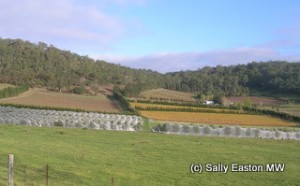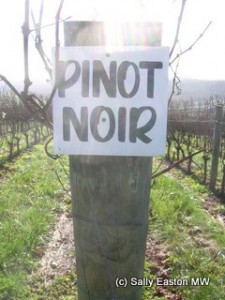Tasmania sparkles
A version of this article first appeared in The Drinks Business, January 2008.
The Tasmania wine industry is very much in its infancy, despite the oldest bottles of Tasmania-made bubbly being recently discovered in Hobart, reputedly dating from the 1840s. But Tasmania has already become the source du force for Aussie traditional method sparkling wine production. About 25% of Tassie’s entire grape production goes into bubblies.

East coast Tasmania
Of ‘native’ producers it’s people like Claudio Radenti of Freycinet and Stefano Lubiana who have lead the way for Tassie sparklers. By all accounts the extremely modest Radenti took some persuading to put his name to the Freycinet sparkler. He said: “Tas is a great place for sparkling, it’s so similar to the champagne climate it’s not funny. The temperature, humidity and sunshine of Champagne and Tassie line up pretty well. There’s lots of potential to make the best nationally.”
Dr Andrew Pirie is another long-time talent who has arguably done more than anyone to plough the furrow for all Tasmanian wine. Now heading up Tamar Ridge, as well producing his own wines under the Pirie label, he said: “Tas sparkling pinot has a natural mid-palate fruit sweetness and richness which seems lost in warmer areas and seems to be one of the features of true cool climate sparkling fruit.”
The new Pirie NV sparkler will be released later in 2008, the aim for which he said is to be a “complex, soft and rich 50/50 chardonnay/pinot noir, with mid-palate fullness from good Tas pinot noir, and taut, but not aggressive, acidity from the chardonnay.”
The big boys on the mainland were not slow to realise the potential of Tasmania’s ‘true cool climate’. Domaine Chandon ’s winemaker, Matt Steel, said: “We have been sourcing from Tasmania since 1992 to use in our vintage-tier sparkling wines. It is part of our philosophy of building wines of complexity through regional diversity of fruit supply. We source base wines from regions such as Macedon, the Whitlands plateau, Strathbogie and Tasmania. The Tasmanian base wines generally exhibit a flinty aromatic, fine structure and very long length of flavour.”

Sparkling fruit
Hardy’s bought the Bay of Fires winery in 2001 having sourced fruit from Tas for several years prior to this. Bay of Fires sources fruit from all over Tasmania for their three labels of sparkler: Arras, Bay of Fires and Tigress. Ed Carr, Hardy’s group sparkling winemaker, said: “Tasmanian grapes have a greater level of minerality than the mainland. The wines exhibit a structural elegance, suppleness and longevity which is essential for the production of premium sparkling wine. These characteristics allow the wines to be aged to a high level of flavour maturity and complexity and yet retain a freshness and brightness that is only seen in world class sparkling.”
Whilst Jansz was one of the first sparkling wines from Tasmania, it’s fortunes have been blooming since the purchase, in 1998, by the Hill Smiths of Yalumba. Robert Hill Smith said “while Australia is seen as the home of robust big reds, sparkling winemakers in Tasmania are quietly producing wines that give most genuine Champagnes a run for their money in quality and price.”
That most of the big producers have already invested in Tasmania fruit illustrates the excitement generated for the quality of its bubblies. Hill Smith said: “Jansz has a single-minded focus to be among the best in the world.”



